Dec 1
Photos of Thamel neighborhood:
The dirt street next to our hotel.
The streets were all narrow just like the one above; people just walked down the middle of the street two, three and even four abreast til they and we heard the tinkling of a bicycle rickshaw bell, a pushcart or the insistent honking of a car horn or the almost constant roar of motorcycles which made us scurry to the side of the road.
It was normal seeing people selling food on the many, many squares we walked by.
Jeans Joint! We saw a lot of stores advertising jeans.
What a really exciting place it was to wander around - I just loved people watching and getting a sense of the area but we sure had to be aware of cars, motorcycles, etc coming at us from all directions and adjust accordingly. Luckily dear Steven was looking our for me as I had the camera glued to my face the whole time!
Andrew: I kept thinking of you when I was taking photos of 'life on the streets.'
We saw many of these signs while walking around and learned the Newa tribal people have been wanting their own state comprised of Kathmandu and surrounding districts since at least 2009.
Down a narrow alley was the Yatkha Bahal above and below.
Our ultimate goal on the walking tour was Durbar Square and we were finally getting close to it.
As you can see from the photos, the palace suffered extensive damage in the earthquake.
We didn't feel like walking up this 'Safe Zone' area.
Our guide showed us Kotilingeshwor Temple next. It was built in the sixteenth century in Gumbaj or dome style. Above, one of the 4 faces of Shiva, the fertility goddess.
The huge stone image of Kol Bhairav, the Hindu deity of Justice is undated. It was set here by King Pratap Malla after it was found in a field north of the city. The king was a great art lover and, whenever he found art pieces, he would install them in the palace square. We passed by here a number of times while in Kathmandu, and there were many worshipers present each time.
We then said goodbye to our Durbar Square tour guide, above, as we decided to embark on another walking tour by ourselves as we still wanted to discover more ofKathmandu . This one led us south
from Durbar Square
More men's Nepali hats for sale.
Sunken water tank or hiti next to the highly decoratedBhimsen Temple, below
Collecting water from the remains of what had been the deep and ornate Kohiti water tank.
I was sure glad I wasn't the one who needed to push this load up the hill on a bike.
Likely getting ready for a wedding procession.
Above and below, the Shikhara Temple.
Down an alley we then came across Ta Bahal. A bahal in case you've forgotten is a courtyard.
We had spent some time chatting with the boys, above, while wandering around the bahal. They were extremely friendly and inquisitive, wanting to know where we were from, our names, whether we liked Nepal, etc.
Near the top, the steps were lined with pairs of lions, elephants, peacocks and horses.
Interesting mix of people at the top of the temple.
Tokens for sale!
Noticed the dance or possibly the performance was being videotaped.
A very hazy sunset in Kathmandu Valley.
The long hike down amid Buddhist prayer flags.
We were pretty tired after doing all the sightseeing and were glad to have a pleasant dinner out near the hotel. I had sweet and sour chicken and Steven ordered spaghetti bolognese again. Unfortunately the restaurant we chose only had outdoor seating so it was a tad nippy dining there.
Posted on 12/17 from Delhi, India.
This will be my last post for a bit as our three and a half month adventure is ending and we will be flying home in a few hours via a night in London. I promise to write up the rest of the posts on Kathmandu and then about our travels to the Indian cities of Varanasi, Agra, Jaipur and Delhi as soon as possible.
Until the next post, my sincere thanks to each of you for taking the time and expressing an interest in our journey. Steven and I hope you have enjoyed being our armchair travelers and wish you and yours the very best.
Annie
We arrived in the Nepalese capital of Kathmandu
about 4:30 after a 4 plus hour
flight from Kuala Lumpur , Malaysia
As we knew there would be no complementary food or beverages served on an Air Asia flight, I was sure glad that we had brought snacks with us on board. We obviously disregarded the pilot’s announcement, once we were finally underway, that said no outside food or beverages could be consumed on the plane.
How exciting to see views from the plane of the Himalayas
as we neared Kathmandu . I wondered if one of them was
the fabled Mt. Everest Kathmandu was two and three quarters hours
behind Malaysia
– what a funny time zone.
We were surprised to notice relatively little damage from
the massive earthquake that Kathmandu suffered in April
as we were driven to our hotel. Steven commented that the traffic gridlock was
the worst we’d ever seen and even surpassed Yangon ’s
which was saying something. I think he was probably right. Try and imagine
driving in a major city with no traffic lights, no stop signs, no one directing
traffic and hundred upon hundreds of cars and motorcycles going every which way
and you get a sense of what we faced on the hour long drive.
We noticed right away it was a lot chillier in Kathmandu
than what we’d been accustomed to in the last 3 months. It was very strange
having to wear our pants, lightweight fleece jackets and our 'heavy' coats again having been so
used to just wearing short sleeve shirts and shorts or capris. The last time we had needed to dress so warmly had been in Canberra, the capital city of Australia. The temperature
was about 70 in Kathmandu but people were wearing heavy coats and hats so we knew it would
only get colder.
We checked into our hotel, located
in the Thamel district of Kathmandu, only to
discover our room was up 5 flights of stairs. Yes, it had a balcony and a
double bed, one of only 2 such rooms in the hotel, but we could have done
without either if we had been on a lower floor. That was reinforced when the
heat and all the lights, save one, went out almost immediately.
Later, when we schlepped
downstairs, we learned that unannounced power outages were common here in Kathmandu and had been going on for the last 2 months ever since the
Indian government had halted shipments of cooking oil, gasoline and other products
across their borders with Nepal . According to the Nepali people we talked to, this
occurred because the Indian government disliked the new Nepali
Constitution.
The hotel had a backup power
but that only meant we had a light in the bathroom and one in the bedroom but
of course no heat or electricity. Thank goodness we had a warm comforter and
each other though! We knew how fortunate we were compared to millions of
Nepalese who didn’t have any backup power at all and were facing a very cold
winter ahead with no prospects of relief in sight.
We were tired, cold and hungry but we couldn’t wait to go
out and explore the area around our hotel. It was so exciting for me especially wandering around for a couple of hours as I had heard so much about Kathmandu from Steven who had been there back in 1970. The Thamel area was absolutely chockerblock full of travel agencies, trekking shops and especially shops selling wonderful Nepali handicrafts. I was in hog heaven with the latter!
Alexander: Thought of you right away when we saw so many displays of these hats that were just like yours. Where did you get yours by the way?
12/2
We decided to take a walking tour from our hotel toward
Durbar Square
The dirt street next to our hotel.
The streets were all narrow just like the one above; people just walked down the middle of the street two, three and even four abreast til they and we heard the tinkling of a bicycle rickshaw bell, a pushcart or the insistent honking of a car horn or the almost constant roar of motorcycles which made us scurry to the side of the road.
The first square we came to was Thahiti; the street
of the same name wrapped around a fifteenth century stupa.
The Nateshwar
Temple
It was normal seeing people selling food on the many, many squares we walked by.
Radiating colorful Buddhist prayer flags at Kathesimbhu Stupa above. More photos of it and the square below:
I couldn't remember seeing for a
very long time as many pigeons as we did here at Kathesimbhu Stupa. I could feel my hair flutter as
the pigeons flapped their wings inches from my head as I stood atop the stupa. Luckily that was all I felt!
In the small recessed area we saw a stone relief and then an
almost unrecognizable orange colored Ganesh head dating from the ninth century. Ganesh is one of the best known and most worshipped Hindu deities.
We left the square and continued our walk. This wooden balcony is said to have had the first glass
windows in Kathmandu .
We passed a string of dentists' shops advertised by signs
showing grinning mouthfuls of teeth.
Steven remarked that the sights and sounds were much as he
remembered them from his journey to the Kathmandu area so long ago.
In the middle of a nearby square,
we saw the double roofed Sikha
Narayan Temple which had a
kneeling Garuda figure. A garuda is a bird-like Hindu figure.
Look at those electrical wires – surely a nightmare, you’ve
got to think, for electricians to find and attempt to fix problems.
On the corner of the same square, there was a lump of wood
into which thousands of coins have been nailed. The coins were offerings for
the toothache god. That explained all the dental shops we'd just passed.
Couldn't resist this photo obviously!
Next we saw the triple roofed Ugratara Temple where I read
that a prayer at the half sunken shrine is said to work wonder for the eyes.
Gated entrance to Haku Bahal (a bahal is a monastery
courtyard); we admired the finely carved
wooden window overlooking the courtyard which doubled as a parking lot
for motorcycles! You can see the supports here because of the earthquake damage in this area.
Next we entered old Kathmandu ’s
busiest chowk, (i.e. intersection) of Asan Tole (i.e.
street). The main road was for centuries the main commercial street in Kathmandu and the start of the caravan route to Tibet .
Photos of Asan Tole below:
What a really exciting place it was to wander around - I just loved people watching and getting a sense of the area but we sure had to be aware of cars, motorcycles, etc coming at us from all directions and adjust accordingly. Luckily dear Steven was looking our for me as I had the camera glued to my face the whole time!
The octagonal Krishna
Temple
Display of Nepalese men’s hats, called topi,
for sale which we noticed most men wearing. Several of the above street photos showed men wearing them.
On the next square was one of the most important temples in
the city, Seto Machendranan
Temple, above
Andrew: I kept thinking of you when I was taking photos of 'life on the streets.'
At the Indra Chawk (intersection) was Akash
Bhairab Temple
To reach the open monastery
courtyard of Itum Bahal,
we had to enter through a tiny doorway under Jenisha Beauty
Salon above . Itum was one of the oldest and largest bahals in the city and used to have lovely
architecture and stupas; now most are in ruins.
We saw many of these signs while walking around and learned the Newa tribal people have been wanting their own state comprised of Kathmandu and surrounding districts since at least 2009.
Down a narrow alley was the Yatkha Bahal above and below.
In the courtyard were the ‘temporary’ structures due to the
earthquake. I wondered with the onset of winter how much longer residents will have to live in the corrugated metal structures.
We noticed the carved wooden struts in the building above and, below, what must be one of the skinniest buildings I’ve ever seen!
Our ultimate goal on the walking tour was Durbar Square and we were finally getting close to it.
We passed a number of shops selling musical instruments as Kathmandu
has many marching bands which are mostly used for wedding processions.
Photos of Durbar Square:
Onto Durbar Square and the heart of Kathmandu .
The ancient ‘square,’ spread over a 5 acre area, was where the kings of Nepal
were once crowned. One of the 7 UNESCO World Heritage Sites in the Kathmandu
Valley museum of Nepal
We had to buy a ticket to enter the Square and we were asked
repeatedly to show it as we walked around the complex comprised of 3 loosely linked squares.
In the square were countless
temples, statues, courtyards and other magnificent structures but the April,
2015 earthquake sadly destroyed much of its former grandeur. Many of the
structures in the square were built by the Malla Dynasty between
the sixteenth and eighteenth centuries, though inscriptions from as
early as the seventh century have also been found in the complex.
We’d been asked every few minutes
all morning if we wanted taxi rides or carriage rides, if we wanted to but this
or buy that. That escalated tenfold when we entered Durbar
Square . There was
a constant stream of people coming up to us wanting to sell small cloth
bags, braided bracelets and necklaces, flutes, postcards, etc. The prices were
astonishing low but there wasn’t a thing we wanted or needed. It was very hard
having to say ‘No thank you’ all the time especially when many of them tried to
establish a personal connection by asking where we were from, how much we liked
their city and kept following us thinking we would weaken and buy something.
A common sight too was of ‘tour guides,’ i.e. men who came
up to us and asked us in good English to hire them for an hour or so they could
show us the huge square. We had a good walking tour map we’d been following but
decided to hire one young man who was very good and showed us a number of
highlights that no doubt we’d have missed on our own.
Our guide took us first to Kumari Goddess Temple which was built in 1757 by the last Malla king as the
residence of the living goddess Kumari. According to local
legend and supported by the tour guides who 'call' to her, the current Kumari
still makes occasional appearances at this window below. Our guide called her
but she didn't make an appearance for us!
We walked next to the white, neoclassical style Gaddi Baithak aka the Coronation
Building
Notice the marble design
at the bottom: it’s the Union Jack, i.e. part of Great
Britain
Our guide next showed us Basantapur Square Durbar Square
Photos of Basantapur Square:
Photos of the 15th century Hanuman
Dhoka Royal
Palace:
An icon, below, of Hanuman was installed in front of the main gate
of King Pratap Malla’s palace, above, for protection and to achieve victory in wars.
The entire palace square got its name from this.
In the palace courtyard, there was a beehive of activity
with both the military and civilian workers removing earthquake debris.
The first king of Nepal who, o ur guide said was responsible for uniting the country. Nepal no longer had a king after 2008.
The sixteenth century Muslim style Taleju Temple had been the tallest temple in Durbar
Square . Taleju Bhawani
was the clan goddess of the Malla royalty.
Women, our guide said, formerly from the Indian state of
Rajastan, who come to this spot twice a week sitting and praying for good
health.
We didn't feel like walking up this 'Safe Zone' area.
Our guide showed us Kotilingeshwor Temple next. It was built in the sixteenth century in Gumbaj or dome style. Above, one of the 4 faces of Shiva, the fertility goddess.
The huge stone image of Kol Bhairav, the Hindu deity of Justice is undated. It was set here by King Pratap Malla after it was found in a field north of the city. The king was a great art lover and, whenever he found art pieces, he would install them in the palace square. We passed by here a number of times while in Kathmandu, and there were many worshipers present each time.
On the south end of Durbar Square
was a small street called Freak Street Freak Street Freak Street Freak Street Freak Street
But in the early 1970s, the
government of Nepal started a roundup of hippies on Freak Street India US Nepal Nepal Nepal
As we wandered
down the busy street, we saw cheap guest houses, trekking agencies, lots of
souvenir shops and small restaurants and I could only imagine what the area was
like 40-50 years ago.
We then said goodbye to our Durbar Square tour guide, above, as we decided to embark on another walking tour by ourselves as we still wanted to discover more of
Communal newspapers in Durbar
Square .
Before and after photos from the earthquake damage.More men's Nepali hats for sale.
Sunken water tank or hiti next to the highly decorated
Collecting water from the remains of what had been the deep and ornate Kohiti water tank.
I was sure glad I wasn't the one who needed to push this load up the hill on a bike.
Above, the remains of what had been the tall, triple roofed, seventeenth century Jaisi Deval Temple which had stood on a 7 level base. As I had so
often thought today, how stunning this and the other destroyed temples must
have been. With the current state of the Nepali economy and infrastructure, I
wondered if the formerly magnificent temples in Kathmandu
will ever be restored to their former grandeur.
Likely getting ready for a wedding procession.
Above and below, the Shikhara Temple.
Down an alley we then came across Ta Bahal. A bahal in case you've forgotten is a courtyard.
We had spent some time chatting with the boys, above, while wandering around the bahal. They were extremely friendly and inquisitive, wanting to know where we were from, our names, whether we liked Nepal, etc.
We walked on to the open Lagan Square
and the 5m high Machendrath Temple a few feet away. More photos of it below:
We finished our second walking tour at 1 and went back to
the hotel to relax for a bit. Later that afternoon we headed out to the Buddhist
Swayambhunath Temple
Photos of Swayambhunath
Temple
I had read that ‘a journey to the UNESCO World Heritage Site
of Swayambhunath (Sway from now on) is one of the definitive experiences of Kathmandu .
Mobbed by monkeys and soaring above the city on a lofty hilltop, the ‘Monkey
Temple
According to legend and geological evidence, the Kathmandu
Valley
We saw many artisans plying their talents at the temple. This lady asked me to look at her carvings and I told her I would later. She said she'd look out for me and she did!
There are 2 ways to approach the temple but by far the most
atmospheric was the stone pilgrim stairway that climbs the eastern side of the
hill. We chose to ascend the steep steps that were built in the seventeenth
century. As we walked up, we could see a collection of brightly colored Buddha
statues and lots of rhesus macaques scampering about from step to step and side
to side.
Near the top, the steps were lined with pairs of lions, elephants, peacocks and horses.
At the top of the steps was an enormous, brass plated dorje,
i.e. thunderbolt, one of the core principles of Tibetan Buddhism. The
thunderbolt is a symbol of the power of enlightenment which destroys ignorance
but is itself indestructible. In rituals, the dorje is used to
indicate male power while female power is represented by a ceremonial bell.
The stupa was surrounded on all sides by a veritable
sculpture garden of religious monuments.
From the gilded spire, 4 faces of the Buddha stare out
across the valley in the cardinal directions. The nose like squiggle below the
piercing eyes is actually the Nepali number ek, i.e. one,
signifying unity, above is a third eye signifying the Buddha’s insight.
The
entire structure of the stupa is symbolic – the white dome represents the
earth, while the 13 tiered beehive structure at the top symbolizes the 13
stages that humans must go through to
reach nirvana.
When Steven spent time here in Kathmandu
45 years ago, he didn’t remember seeing any souvenir sellers. I can hardly
imagine a time like that existed as they were everywhere now.
The base of the central stupa is ringed by prayer wheels
embossed by a sacred mantra; pilgrims circuiting the stupa spin each one as
they pass by.
Interesting mix of people at the top of the temple.
After walking clockwise around the temple at least twice, we
then took the western stairs down as Steven thought he had stayed in that part of Kathmandu
all those years ago.
We watched men throw tokens into the peace fountain trying
to get them to land in the center, just like at an amusement park!
We had heard music playing so climbed nearby steps and saw
some people having a lot of fun dancing.
Noticed the dance or possibly the performance was being videotaped.
A very hazy sunset in Kathmandu Valley.
We walked around the temple one last time before going down
via the Eastern Stairway again.
As with almost any place of worship we’ve been to this trip,
there were lots of souvenir sellers on the steps of Swayamabth
Temple
She was the friendliest woman I can remember
meeting and interacting with in a long time. She said the price was only 150 NP
but she didn’t mind, she’d take 200 instead! Well, I bet you can guess who now
are the proud owners of a roll of Buddhist prayer flags and it only cost us 200
NP, about $1.60! There was no way either one of us could have walked away from
her sales pitch! She could have sold ice to Eskimos (or Inuit to be politically
correct), she was that good. The 3 of us got a good laugh out of that exchange
and Steven and I left with really fond memories of our time at Swayambath
Temple
Just as we were leaving I watched a man beginning to run up the steps like he was
Rocky Balboa – I wonder if he made it all the way up without stopping!
On the taxi ride back to the hotel, our driver pointed out
the wedding procession taking place.
We were pretty tired after doing all the sightseeing and were glad to have a pleasant dinner out near the hotel. I had sweet and sour chicken and Steven ordered spaghetti bolognese again. Unfortunately the restaurant we chose only had outdoor seating so it was a tad nippy dining there.
Posted on 12/17 from Delhi, India.
This will be my last post for a bit as our three and a half month adventure is ending and we will be flying home in a few hours via a night in London. I promise to write up the rest of the posts on Kathmandu and then about our travels to the Indian cities of Varanasi, Agra, Jaipur and Delhi as soon as possible.
Until the next post, my sincere thanks to each of you for taking the time and expressing an interest in our journey. Steven and I hope you have enjoyed being our armchair travelers and wish you and yours the very best.
Annie









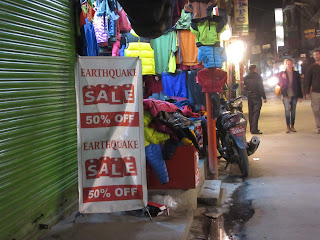
































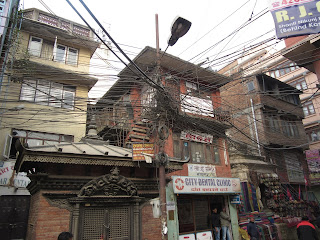









































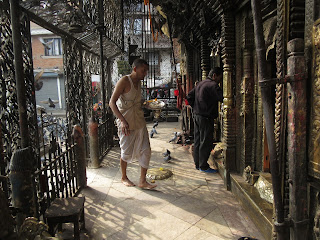





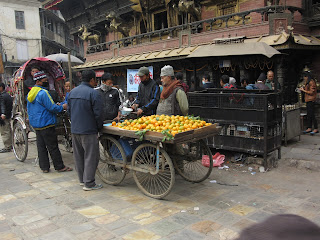




















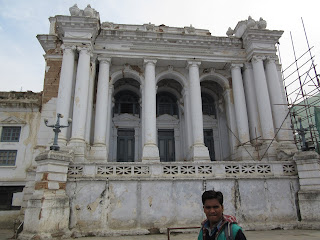













































































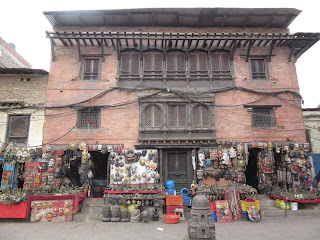

































WELCOME HOME... Lil REd
ReplyDelete